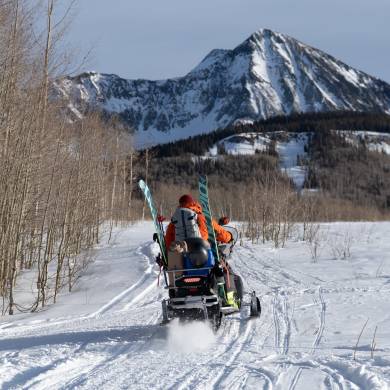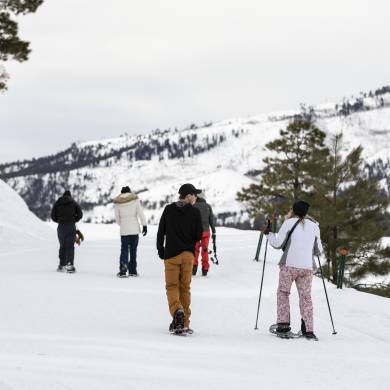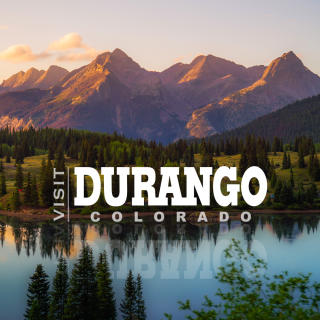Historic Walking Tour Facts
Brief History of Durango
Before there was the City of Durango there was Animas City—it was located north of the current city of Durango. Animas City was founded 1876, the same year Colorado became a state. It was named after the nearby Animas River—El Rio de las Animas Perdidas (River of Lost Souls).The City consisted of farmers, ranchers, miners, and a newspaper. It was also home to Camp Animas-cavalry and infantry named after the Ute agent.
1880—Animas City was a small bustling community north of current City of Durango was the trade center of the area and had 286 residents.
1879-1880: Denver & Rio Grande Railway built the San Juan Extension into the valley in 1881 and founded a new town. Durango was surveyed and platted in September 1880. Durango was located 2 miles south of Animas City. Most businesses moved from Animas City to Durango and in 1948 Animas City annexed to Durango. Clash of D&RG with Animas City: Animas City wanted a dowry (land for depot, grading, purchase of stock) from the train. Animas City held its ground and the train chose to form a new city for this opportunity: Durango. Name “Durango” means water town, there was a Durango Mine and also Durango, Mexico and Durango, Spain. Some people wanted to name it Palmer City after D&RG visionary or Smelter City after the smelter.
Durango Trust—a business group composed largely of D&RG Railway investors who decided to bypass Animas City-seeking cheap land from homesteaders. Investors paid $105,000 to start the city.
1880 William Bell, a friend of William Palmer, buys 160 acres for $500 and donates land for school, City Hall
William Palmer—Denver & Rio Grande founder, donated land for city to use
City of Durango was well planned and had 200 residents by Christmas of 1880. Durango became commercial center of the Southwest: mining, smelting, logging, banking, agriculture.
Streets were planned: Main Avenue—wholesale business, 2nd Avenue—retail business, 3rd Avenue—residential street
1881 Smelter in operation on Smelter Mountain—business stole much from Silverton’s economy. Was successful partially due to the coal available in Durango—“black diamonds”. John Porter decided to locate the smelter in Durango due to cheap fuel, labor, climate, and ore to the smelter on a downhill route. Porter was a smelting brainchild. In 1887, they smelted 1 million pounds of silver, lead, gold and copper and were largest employers with 300 men employed at a time. The smelter gave off air that smelled like rotten eggs as the smelting process: crushed the ore, heated and mixed with chemicals to make gold and silver bullion.
1881—Government forms to combat unruliness. Wild youth, feuds between Colorado & Farmington, New Mexico over cattle and range land. These were the shenanigans that Hollywood and TV Westerns portray! Check your weapons at the bar. Durango becomes County Seat. There were 20 saloons and 8 more surveyed. Lawlessness in the City—Ike Stockton commits the first hold up, no jail at this time. Caroline Romney, writes “The Record” newspaper, coins Durango as the “City in the Wilderness”. She wanted Durango to be the Capitol of Colorado. Silverton drove out gambling houses to Durango.
1884—Trust turns into a company: Durango Land and Coal Company
1886—Nearby town of Cortez made a city with no train service it is not considered a threat.
1887--electric lights
1893—Brookside addition to Durango—now there is only a hotel on the site. Crash of 1893: Depression followed, silver mining never rebounds. First football game played in Durango.
1904--Animas City School formed
1905--San Juan National Forest created
1909--Three theatres operating in town
1911--100 year flood, worst in history of Durango, water 4 ft deep in some streets. First cars come to Durango.
1914--Durango Club formed and later became the Chamber of Commerce
1919--Flu epidemic hits area
1920s-Bootleggers, speakeasies. Ku Klux Klan, abundance of agriculture
1925—Tourism focus for Durango—“Come play and you’ll want to stay” motto.
1929—Durango/La Plata County Airport opens
1930s--Population of Durango hits 5,000 people
1934--Gasoline cost 34 cents a gallon, Municipal golf course opens
1940s-Smelter facility closes
1957- Fort Lewis College dedicated
1960s-Purgatory Ski Resort opens
Durango & Silverton Narrow Gauge Railroad Depot
479 Main Avenue
August, 1881 --Railroad arrives in Durango and continued toward Silverton by July 1882
Those involved with the train were always aware of the spectacular experience a ride presented, and they promoted scenic rides from the train’s inception. The train was officially promoted as a scenic tour beginning in July of 1882. It was promoted in 1951 as solely a passenger train and not as a freight train.
Narrow gauge rails are three feet (thirty-six inches) apart, while standard gauge rails are four feet, eight and one half inches (56 ½ inches) apart.
Actually, General Palmer implemented narrow gauge and narrow passenger cars because he wanted to prevent men and women from being able to sleep in the same bed on the train (the narrow passenger cars only have room for single sleeper bunks on each side). These cars are also less expensive and easier to bring through the rough mountain terrain, so they became popular. The rails were also less expensive to install (it’s easier to blast out a narrower track on the side of a mountain) and can make sharper curves around mountains.
Throughout the course of many years, over three hundred million dollars in precious metals has been carried on the D&SNGRR.
The train needs six tons of coal and ten thousand gallons of water for a round-trip.
The train travels at an average speed of 18 mph can reach 25 mph and No. 42 can reach 35 mph.
K-36’s weigh one hundred forty-three tons when loaded with coal and water.
Concession Car #212 was built in 1879.
No. 42 was built in 1887 and is on display in the museum. The locomotives used daily are from 1923 and 1925.
American Heritage Railways of Coral Gables, Florida, purchased the railroad in the summer of 1998 under the leadership of Chairman Allen C. Harper and President Carol Harper.
Rio Grand Southern from Durango to Ridgeway in 1891. Five outgoing rail road lines ran from Durango.
Has the train “starred” in any movies?
Colorado Territory (1949), Ticket to Tomahawk (1950), Denver and Rio Grande (1952), Viva Zapata (1952), Three Young Texans (1954), Run for Cover (1955), Maverick Queen (1956), Around the World in 80 Days (1956), Night Passage (1957), How the West Was Won (1963), Butch Cassidy and the Sundance Kid (1969), Support Your Local Gunfighter (1970), Durango & Silverton Narrow Gauge Railroad (1984), The Tracker (1987), Rebirth of a Locomotive (1992), Durango Kid (1999), The Claim (2000).
Famous people who rode the train:
Robert Redford, Paul Newman, Marilyn Monroe, Marlon Brando, Anthony Quinn, James Stewart, Debbie Reynolds, John Wayne, Henry Fonda, Gregory Peck, Cloris Leachman, James Garner and Suzanne Pleshette, Ernest Borgnine, Robert Urich, John Denver, Warren Beatty, Michael J. Fox, Howie Long, Dennis Weaver, Ricky Lee Jones, Michael Martin Murphy, Kris Kristopherson, President Gerald Ford, and President William H. Taft among others.
Main Avenue
Main Avenue in the mid 1880s was dusty in the summer, muddy after rains, and polluted by horses, mules and burros. Ladies faced a challenge when they crossed the street to dirty their skirts—they were considered unladylike if they raised their skirts above their ankles. In the evening gas lights dimly lit the street. Horse drawn streetcars (1891) that cost a nickel a ride ran Main Avenue to the Animas Bridge—changed to electric cars in 1893. Sidewalks were made of wood.
500 Block
Focal point for the Italian-American community in early 1900’s. Soot from train and smoke from smelter were obvious and frequent.
Between railroad and river was called “Poverty Flat”—the town’s red light district, saloons, gambling, dance halls, squatters, and generally a slum .
552: 1906, Belleview saloon and rooming house
528: DiUbaldo Grocery
532: Saloon, served soft drinks as a soda fountain during prohibition
546: New building that replaced the Fiorini Home. Fiorini’s monument shop still operates behind this store
600 Block
605: 1883, Wetter Building –oldest building on the block. Built as a boarding house, businesses later included Durango Herald printing shop, tin shop, grocery store, soda water factory
643-645: La Plata Bottling Works and Saloon. Owned by Adolph Coors until 1915, during prohibition, John Kellenberger purchased the operation for first Coca-Cola franchise.
699: 1888, Strater Hotel, exemplifies the period of wealth from the mines, railroad and smelter. Durango needed a fancy hotel. The building is an eclectic mix of Italianate, Romanesque, and Renaissance architectural styles. Hotel opened in 1888 and was immediately leased to H L Rice. The partnership soured quickly and 4 years later Henry Strater built the Columbian Hotel next door on the former site of the county courthouse. The two hotels are now one establishment. There is still a bullet hole in the bar of Diamond Belle Saloon from a gun fight. Home of the Durango Opera House with seating for 100- 200 people.There are rumors of tunnels running from the Strater Hotel and 3rd Avenue to the red-light district.
700 Block
The Ute Tribe members were welcomed at allotment time (Ute Tribe settled in Ignacio and Southern Ute Community) and camped at the corner of 7th and Main in teepees and with their ponies. This was valued as a “tourist attraction” for those staying at the Strater Hotel. Southern Utes and other Native American tribes were here before the Europeans settled the area. The Brunot Agreement of 1873 opened land to Utes and Ignacio became their tribal headquarters.
713: The smooth, simple glazed tile storefronts and large glass panel windows illustrate Durango’s modern downtown from the 1930s and40s. When 713 was remodeled form its original Victorian-era, red brick storefront to project the image of the progressive men’s clothing store that occupied the building at the time.
758-764: These stores contain typical architectural elements of a turn of the century storefront. The large windows provided a display area while allowing maximum light to enter the store. The central recessed entryway protected the doorway. The clerestory above the awnings provided extra light. The pressed metal cornice work was mass-produced and used on commercial storefronts throughout the country.
764: Three businesses burned down March, 2007. Seasons reopened March, 2009 in same location. The 3 buidlings were rebuilt in a modern version of their previous structure.
781: 1881, Graden Mercantile Company was largest department store in Durango. It burned in 1948 and was rebuilt. Graden came with the railroad and was one of the founders of Durango.
800 Block
801: 1892, Newman Building. Built in 1892 by Charles Newman, Romanesque sandstone building originally housed the Smelter National Bank (1892-1897). Bank sign is still visible on the back side of the building. Newman owned a chain of drugstores in Silverton, Alamosa, Animas City and Chama. It is believed to be the first business in Durango. The low building to the back of the Newman Building was the Durango Novelty Works—garage for some of the first cars in the area.
835: In 1974 a fierce fire destroyed much of the west side of the 800 block and took 2 lives. The Mall at 835 replaced those buildings.
846: Brick storefront was modernized with a veneer of Carrera Glass, a structural glass popular in the slick, streamlined surfaces of the architectural styles of the 1930s and 40s. Carrera Glass is no longer made. Recent replacement of broken tiles on the storefront led to discovery of a stash of Carrera Glass that a WW2 veteran had brought back with him from Europe and had stored in his backyard for almost 50 years. Much of his cache has replaced cracked original pieces.
858: Built for an attorney’s office and painting/hardware store on street level.
863-871: Showpiece of the Durango &Rio Grande’s land development company. Buildings were to be a model for future building in the community. D&RG tried in vain to require property owners to build in brick and stone only to watch much of the city burn in 1889. Fire of 1889-burned 7 blocks and spread to the residential neighborhood of East 3rd Avenue. Wooden structures replaced with stone and brick which was the Durango Trust’s original idea. Same buildings are still here today.
900 Block
9th and Main Avenue is the site of first survey stake for Durango.
West side of 900 block was the notorious “saloon district” in Durango. Gambling halls and saloons flourished between 1890 and Prohibition Era. Ten saloons were located in the district in 1893. Prosperous local Madame Bessie Rivers held court in this block before she retired to Animas City. Instead of shutting down her business, the city leaders fined the ill-repute and let them carry on with their business. The city needed money so it would fine businesses and let them continue.
900: 1892, Richardson/Romanesque style building housed the Colorado State Bank from 1892 until the bank’s failure during the silver crash of 1907. Burns National Bank has been here since 1910.
901: Oldest bank in SW Colorado, First National Bank of Durango occupied this building. The bank moved from Animas City in 1881 and operated here until 1980. The building is now the Wells Group. Building showcased the first Queen Anne brickwork with Romanesque sandstone arched windows and was built for $18,219. The structure replaced the earlier frame building that burned in 1892 fire.
920: A.C. Richey and Brother operated a bookstore that was later replaced by the Richey Confectionary and Stationary Store. It was a well known local soda fountain for many years with the last remnants of the candy-making business still on the front of the store. Around 1945 marble tiles were added. In the back of the building is the marble candy making block—left behind because it was too heavy to move out of the building.
945: Canton Restaurant (called the Canton Building), was a saloon for period of time. The building still has the original ceiling and floor.
965/969: Two saloons operated here in the heyday of the saloon district. Bessie Rivers ran The Horseshoe Club at 969 Main Avenue. After the saloons closed, two different families by the name of Wong operated cafes into the 1950s.
975: Built in 1892, the four-story French Second Empire Structure characterized by the mansard roof has a varied history as a saloon, post office, bank and hotel. References to French culture were often included in the Victorian commercial architecture as an allusion to the continental sophistication associated with the French. El Rancho. In 1915 at 10th and Main, Colorado native Jack Dempsey “The Manassa Mauler” knocks down Andy Maller in 10 rounds and won $50. In 1919 Dempsey becomes World Heavy Weight Champion.
990: Built in 1889, the Schneider Block housed the Keeley Institute, a reform group devoted to the cure of liquor, opium and tobacco habits. One of four Colorado branches, the Institute operated between 1892 and the turn of the century. By 1900, part of the building had been transformed into a dance hall which stayed in the building until the 1920s. The corner storefront was the Palace Grocery and Meat Market from 1900 to 1920s and continued as a grocery until late 1940s.
1000 Block
1910 era 10th Street had a contingent of Chinese settlers who operated restaurants and laundries. They were the largest minority group, numbering at most 50 people.
1001: 1915, Early Durango movie house, The Gem Theatre, was located in this building in 1915. The building’s original 1890s storefront is gone, but the brick designs on the wall facing Main Avenue bring a unique element to the downtown.
1015: The cast iron and pressed metal front was made by the Mesker Brothers of St. Louis and probably came to Durango by train. These early pre-fab products were popular because they were durable, fire resistant and less expensive than their custom-made options.
1060: Old Post Office built in 1929 and restored in 1985.
1100 Block
1129: Built in 1890, this was the Chapman Hardware Store until 1920s. The glazed brick remodel on the first floor was another modernization project. Original wood frame building burned in great fire of 1889.
1138: The first occupant of this building was the Windsor Hotel. The newspaper, Durango Democrat ( later would become the Durango Herald) moved into the first floor in the 1910s and remained there until the mid 1950s. Look for the old ghost sign for the Herald on the south side of the building.
1200 Block and North
This is the farthest north extent of the Main Avenue Historic District, however historic buildings dot Main Avenue as you continue north. Livery buildings, bottling works, and breweries were in the immediate area. Further north, St Columba Catholic Church, school and Mercy Hospital were started in 1892 by the Sisters of Mercy. The church and school are still at their orginal site. Mercy Regional Hospital recently moved to the Grand View area of La Plata County.



